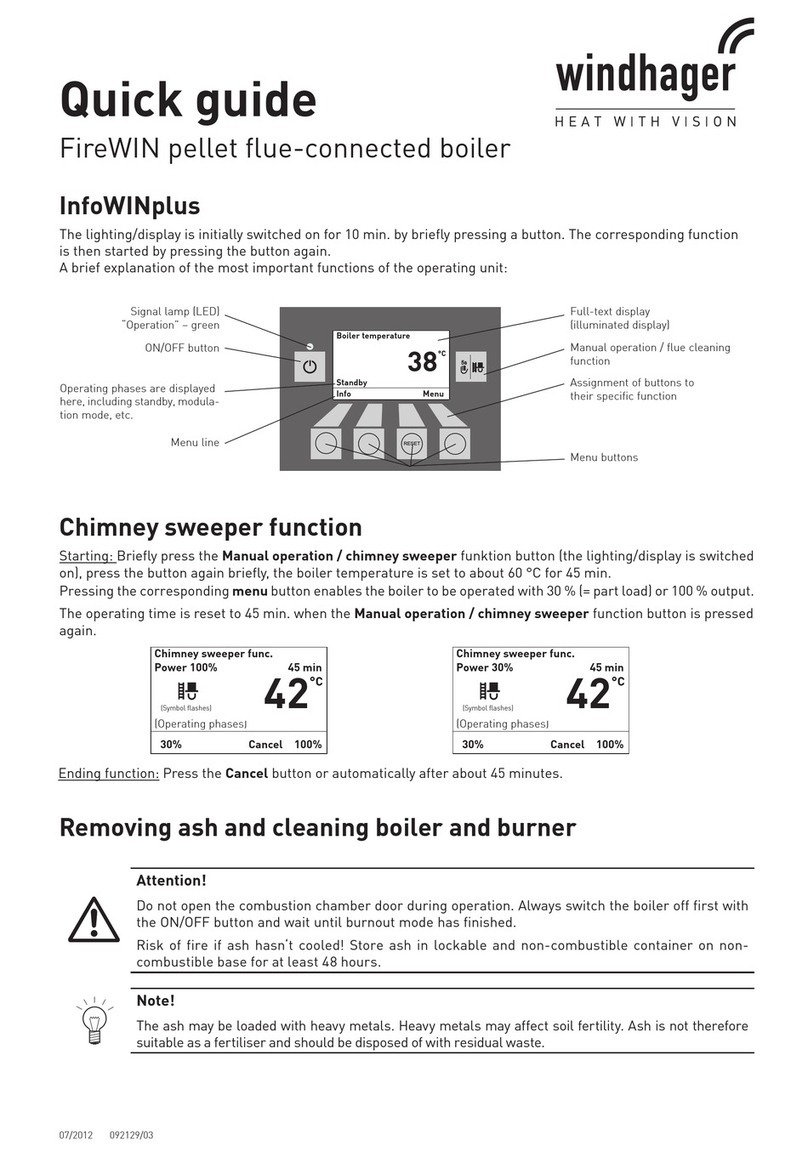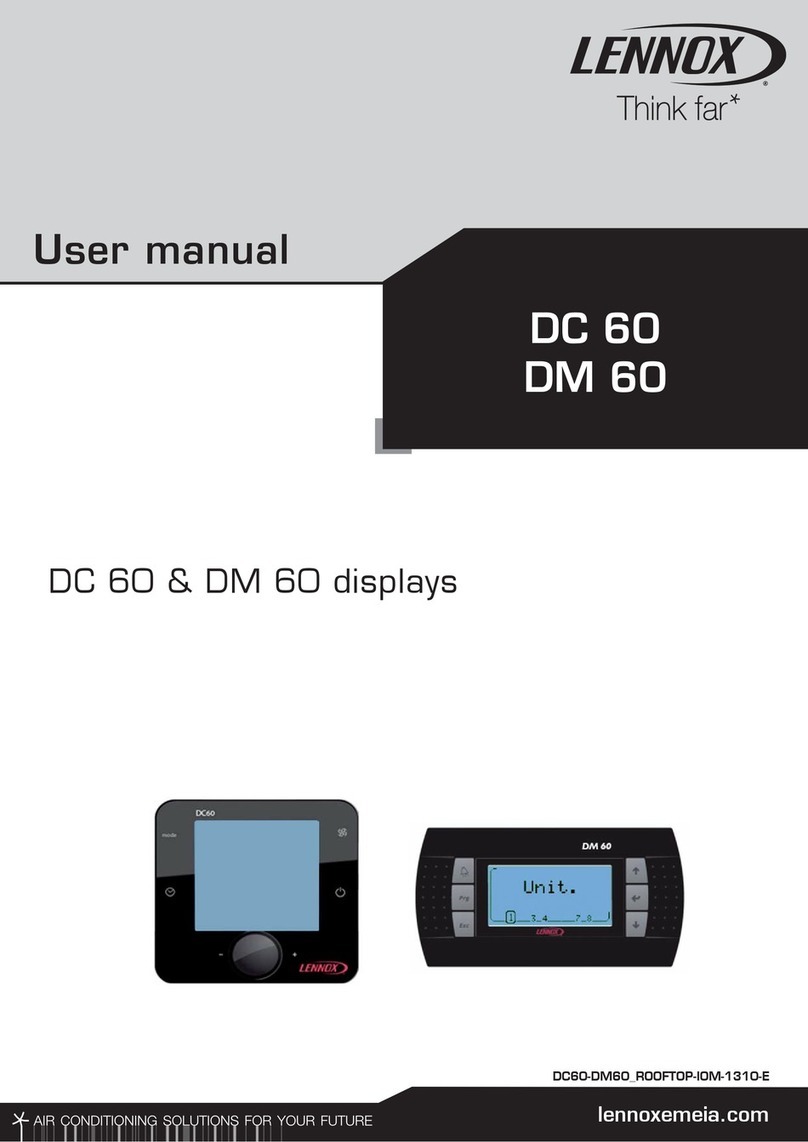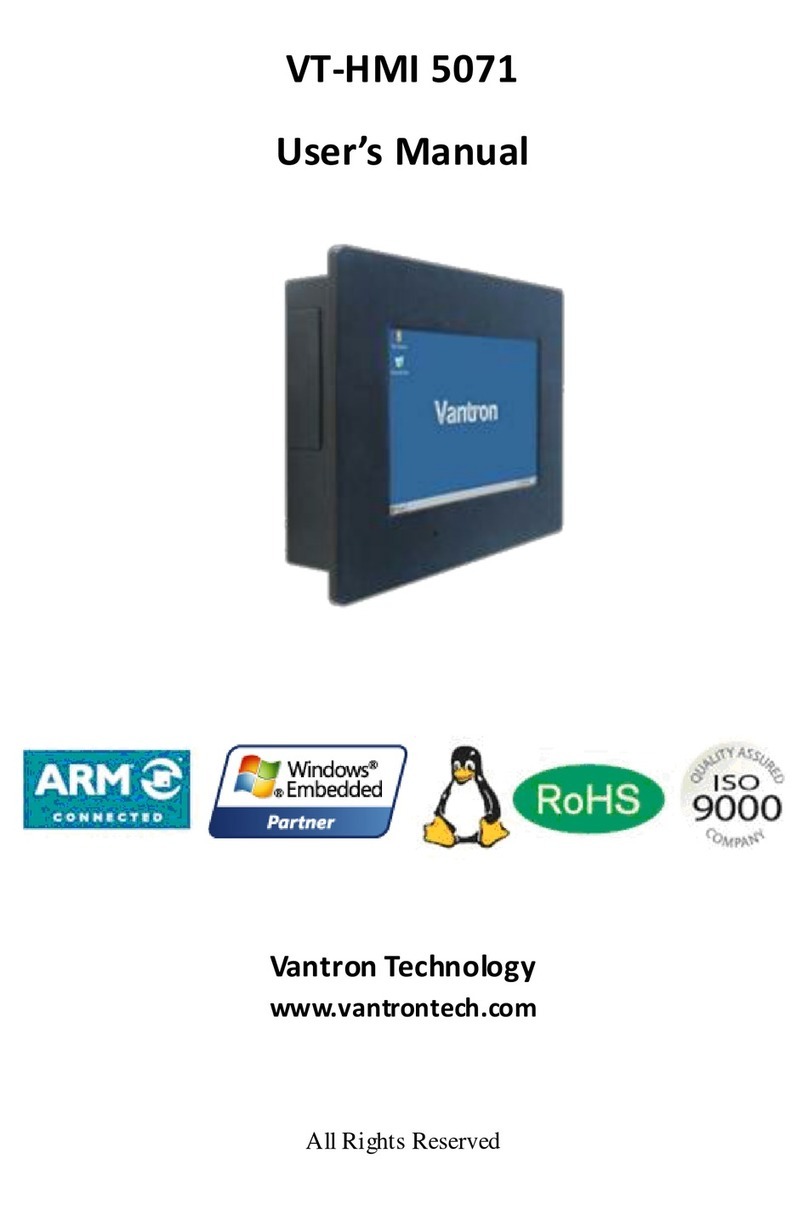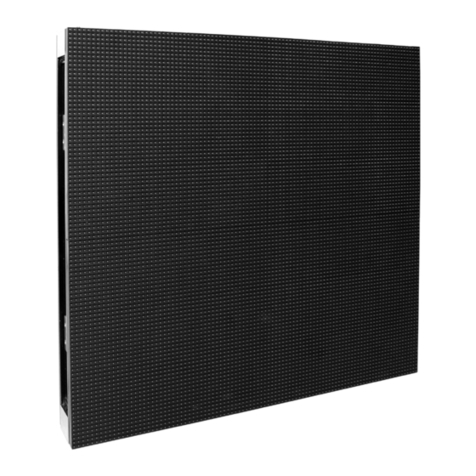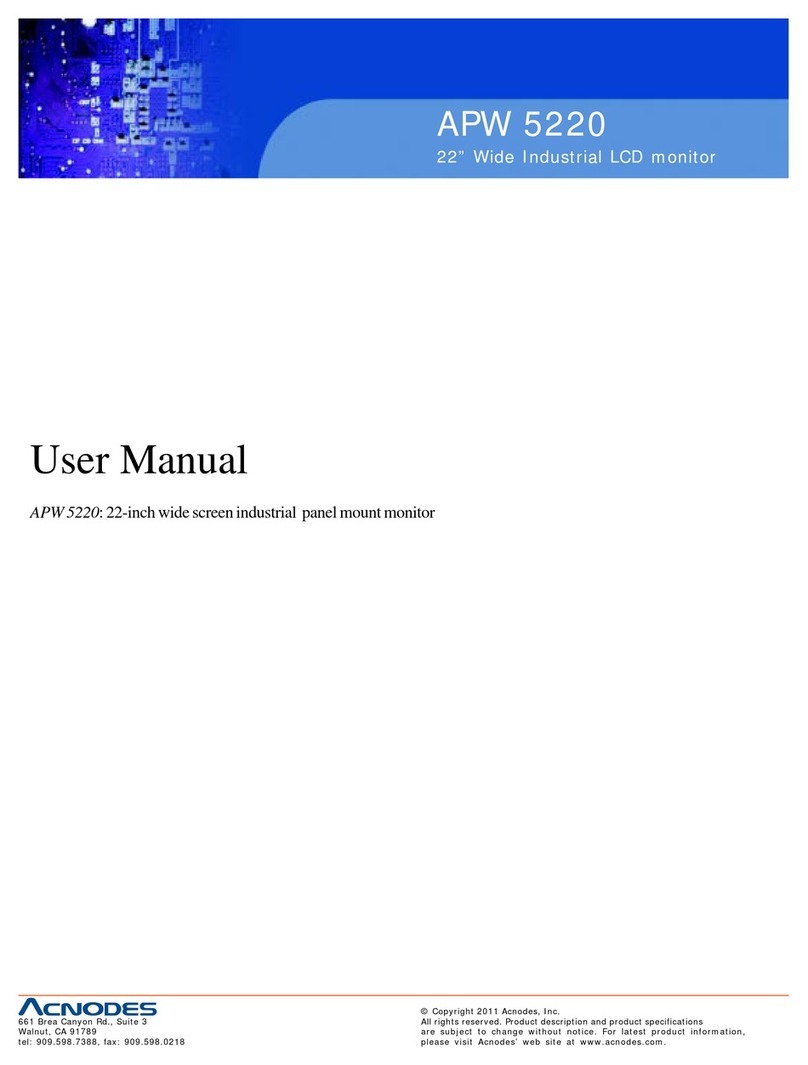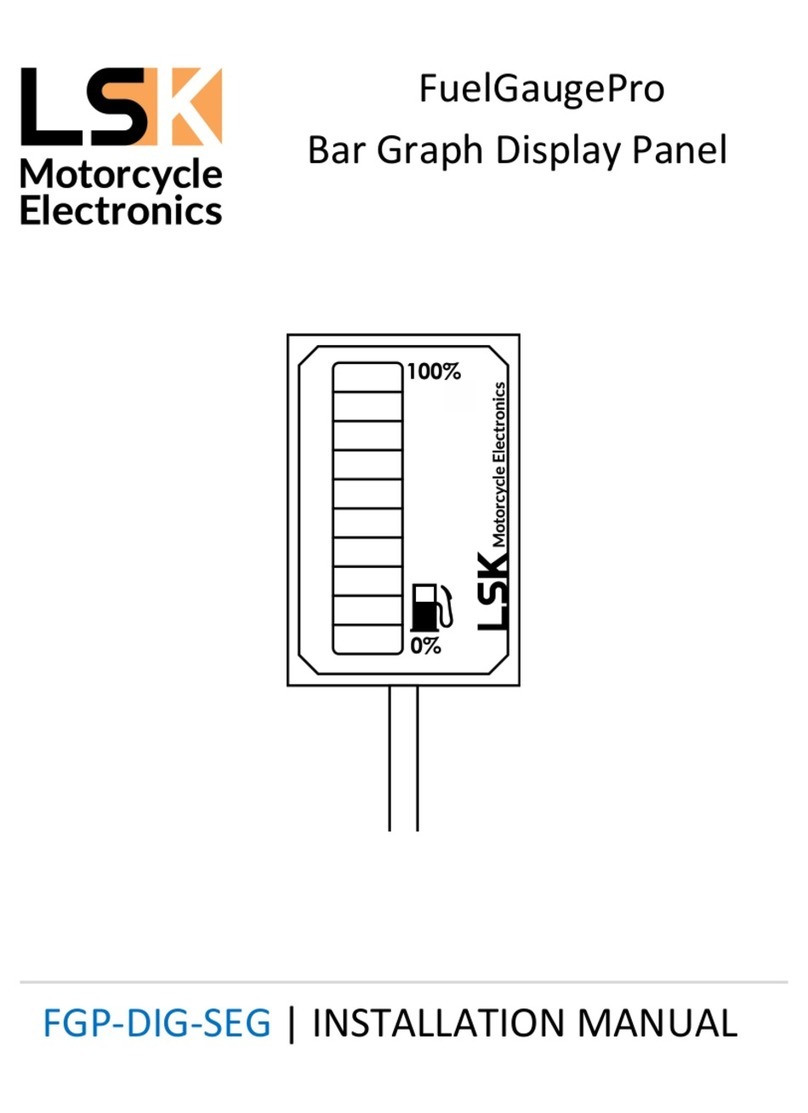Thies CLIMA Winddisplay LED User manual

Winddisplay LED
Instruction for Use
4.3251.0x.001 / 002 / 902
Ship Version V6.6
Dok. No. 021408/04/21
T H E W O R L D O F W E A T H E R D A T A

© Adolf Thies GmbH & Co. KG · Hauptstraße 76 · 37083 Göttingen · Germany 021408/04/21
Safety Instructions
•Before operating with or at the device/product, read through the operating instructions.
This manual contains instructions which should be followed on mounting, start-up, and operation.
A non-observance might cause:
- failure of important functions
- endangerment of persons by electrical or mechanical effect
- damage to objects
•
Mounting, electrical connection and wiring of the device/product must be carried out only by a qualified
technician who is familiar with and observes the engineering regulations, provisions and standards
applicable in each case.
•Repairs and maintenance may only be carried out by trained staff or Adolf Thies GmbH & Co. KG.
Only components and spare parts supplied and/or recommended by Adolf Thies GmbH & Co. KG
should be used for repairs.
•Electrical devices/products must be mounted and wired only in a voltage-free state.
•Adolf Thies GmbH & Co KG guarantees proper functioning of the device/products provided that no
modifications have been made to the mechanics, electronics or software, and that the following points
are observed:
•All information, warnings and instructions for use included in these operating instructions must be
taken into account and observed as this is essential to ensure trouble-free operation and a safe
condition of the measuring system / device / product.
•The device / product is designed for a specific application as described in these operating instructions.
•The device / product should be operated with the accessories and consumables supplied and/or
recommended by Adolf Thies GmbH & Co KG.
•Recommendation: As it is possible that each measuring system / device / product may, under certain
conditions, and in rare cases, may also output erroneous measuring values, it is recommended using
redundant systems with plausibility checks for security-relevant applications.
Environment
•As a longstanding manufacturer of sensors Adolf Thies GmbH & Co KG is committed
to the objectives of environmental protection and is therefore willing to take back all
supplied products governed by the provisions of "ElektroG" (German Electrical and
Electronic Equipment Act) and to perform environmentally compatible disposal and
recycling. We are prepared to take back all Thies products concerned free of charge if
returned to Thies by our customers carriage-paid.
•Make sure you retain packaging for storage or transport of products. Should
packaging however no longer be required, please arrange for recycling as the
packaging materials are designed to be recycled.
Documentation
•© Copyright Adolf Thies GmbH & Co KG, Göttingen / Germany
•Although these operating instruction has been drawn up with due care, Adolf Thies GmbH & Co KG
can accept no liability whatsoever for any technical and typographical errors or omissions in this
document that might remain.
•We can accept no liability whatsoever for any losses arising from the information contained in this
document.
•Subject to modification in terms of content.
•The device / product should not be passed on without the/these operating instructions.

© Adolf Thies GmbH & Co. KG · Hauptstraße 76 · 37083 Göttingen · Germany 021408/04/21
Contents
1Model.............................................................................................................................. 5
2Use................................................................................................................................. 6
2.1 Functions:..................................................................................................................7
2.2 Equipment:................................................................................................................8
3Display............................................................................................................................ 8
3.1 „Rel.“ Wind (Relative Wind) .......................................................................................9
3.2 „True“ Wind ............................................................................................................10
3.3 Course: 180° Wind Display Shifting.........................................................................11
4Operational Characteristics............................................................................................12
5Recommended Choice of Location ................................................................................14
6Installation......................................................................................................................14
6.1 Mechanical Assembly..............................................................................................14
6.2 Electrical Assembly .................................................................................................14
6.2.1 Connection Wind Transmitter............................................................................16
6.2.2 Connection Serial Interface RS422 / RS485......................................................17
6.2.3 Connection Analog Inputs.................................................................................20
6.2.4 Connection Power Supply.................................................................................21
6.2.5 Connection Remote Control..............................................................................21
6.2.6 Connection Sensor Supply only (with 4.3251.0x.902) .......................................22
6.2.7 Optional Connection (Analogue output).............................................................22
7Settings..........................................................................................................................23
7.1 Setting Operating Mode...........................................................................................23
7.2 Setting Wind Transmitter Type ................................................................................24
7.3 Setting Wind Reference NACOS (COM 4)...............................................................25
7.4 Setting Wind Reference CUSTOMER (COM 5).......................................................25
7.5 Setting Baud Rate: ..................................................................................................25
8Data Protocol.................................................................................................................26
9Operation.......................................................................................................................31
10 Functional Test..............................................................................................................35
11 Error Message...............................................................................................................35
12 Maintenance..................................................................................................................37
13 Technical Specifications.................................................................................................38
14 Dimension Diagram .......................................................................................................40
15 EC-Declaration of Conformity ........................................................................................41

© Adolf Thies GmbH & Co. KG · Hauptstraße 76 · 37083 Göttingen · Germany 021408/04/21
Figures
Figure 1: Display ................................................................................................................... 9
Figure 2: Rear panel 4.3251.0x.001 .....................................................................................15
Figure 3: Rear panel 4.3251.0x.x02 .....................................................................................15
Figure 4: Example of Connections........................................................................................18
Figure 5: DIP switch.............................................................................................................23
Figure 6: Operation ..............................................................................................................31
Tables
Table 1: Model ...................................................................................................................... 5
Table 2: Wind Transmitter Connection Table........................................................................16
Table 3: Device parameters .................................................................................................34
Table 4: Error message........................................................................................................36

© Adolf Thies GmbH & Co. KG · Hauptstraße 76 · 37083 Göttingen · Germany 021408/04/21
1 Model
Description
Order - No.
Equipment
Operating voltage
Wind indicator LED 4.3251.00.001 6 x RS422
or
5 x RS 422
1 x RS 485
- Firmware for
Log/Gyro- system
230V AC / 24V AC / 12…35V
DC
Wind indicator LED 4.3251.01.001 6 x RS422
or
5 x RS 422
1 x RS 485
- Firmware for
Log/Gyro- system
115V AC / 24V AC / 12…35V
DC
Wind indicator LED 4.3251.00.002 6 x RS422
or
5 x RS 422
1 x RS 485
1 x Dual analog IF
with pressure sensor
- Firmware for
Log/Gyro- system
230V AC / 24V AC / 12…35V
DC
Wind indicator LED 4.3251.01.002 6 x RS422
or
5 x RS 422
1 x RS 485
1 x Dual analog IF
with pressure sensor
- Firmware for
Log/Gyro- system
115V AC / 24V AC / 12…35V
DC
Wind indicator LED 4.3251.00.902 6 x RS422
or
5 x RS 422
1 x RS 485
1 x Dual analog IF
with pressure sensor
- Firmware for GPS-
system 212520
- supply for
GPS system 212520
230V AC / 24V AC / 12…35V
DC
Wind indicator LED 4.3251.01.902 6 x RS422
or
5 x RS 422
1 x RS 485
1 x Dual analog IF
with pressure sensor
- Firmware for GPS-
system 212520
- supply for
GPS system 212520
115V AC / 24V AC / 12…35V
DC
Table 1: Model

© Adolf Thies GmbH & Co. KG · Hauptstraße 76 · 37083 Göttingen · Germany 021408/04/21
2 Use
The wind display LED is a modern, data processing measuring and indicating instrument for
representation and serial output of the wind direction and wind velocity as „True“ or „Rel.“
value on ships.
„True Wind“ is the wind, which can be observed while the ship is standing still. It is calculated
on the basis of the received data in reference to the ship’s movement and the measured
relative wind. Depending on the setting (refer to chapters 7.3 and 7.4 for interfaces, as well
as chapter 9 for representation on the indicator), the direction of the True Wind either
corresponds to geographic North or to the direction of the ship's bow.
„Rel. Wind“ is the wind measured on the moving ship. The direction of the relative wind
corresponds to the direction of the ship’s bow.
For ships (for ex. ferries) with changing forward or backward course the reference direction
of the wind direction display can be turned by 180°.. For shifting the reference direction there
is a gate input on the back side of the display (see chapter 6.2.4).
The wind display LED offers a high level of reliability and flexibility, as well as optimal display
of the wind parameters.
Coloured light emitting diodes (LED’s), which permit easy readability under a wide variety of
lighting conditions and from various distances, are used for representation. The brightness is
adjustable. Two levels of brightness can be stored via an enhanced dimming function, thus
allowing quick access to individual settings for daytime and night time brightness levels.
Depending on the model, the wind display is equipped with an additional analogue interface
and a Baro transmitter. This permits connection of additional measurement transducers for
Rel. humidity and temperature. The measured values of temperature, Rel. humidity and
atmospheric pressure are displayed serially. The parameters are not displayed.
Depending on the model the wind display is equipped with a firmware for a Log/Gyro system
or with firmware for a GPS system.

© Adolf Thies GmbH & Co. KG · Hauptstraße 76 · 37083 Göttingen · Germany 021408/04/21
2.1 Functions:
4.3251.0x.001
•Measurement of the „Relative Wind“ via the wind interface or RS422 / RS
485 (ultrasonic).
•Reception of NMEA 0183 telegrams with the parameters heading and
ship’s speed.
•Calculation of the „True Wind“.
•Optional indication of „True Wind“ (True) or „Relative Wind“ (Rel.) on the
display
•Output of NMEA 0183 telegrams for PC and other equipment (NACOS
and CUSTOMER).
•Output of NMEA 0183 telegrams for actuation of external Winddisplay
LED
•Im „Master / Slave“ mode, up to 10 further Winddisplay LED’s can be
connected over a maximum distance of 1000m.
•Flexible power supply for the Wind display with 230VAC or 24VAC / 12 -
35V DC (optional 115VAC).
•In addition to front-side operation, external operating buttons can also be
connected via connecting terminals on the rear panel of the Wind display
LED.
•A 180° wind direction correction can be carried out via a connecting
terminal on the back side (ship forward or backward).
4.3251.0x.002
Same as 4.3251.0x.001, however additionally:
•Measurement of the atmospheric pressure and conversion into different
measuring units for data output.
•Measurement of the Rel. humidity and conversion into different measuring
units for data output.
•
Measurement of the air temperature for data output.
4.3251.0x.902
•
Measurement of the „Relative Wind“ via the wind interface or RS422 / RS
485 (ultrasonic).
•Reception of NMEA 0183 telegrams with the parameters heading and
ship’s speed of a GPS- SYSTEM 212520.
•Calculation of the „True Wind“.
•Optional indication of „True Wind“ (True) or „Relative Wind“ (Rel.) on the
display
•Output of NMEA 0183 telegrams for PC and other equipment (NACOS
and CUSTOMER).
•Output of NMEA 0183 telegrams for actuation of external wind display
LED
•In the „Master / Slave“ mode, up to 10 further wind display LED’s can be
connected over a maximum distance of 1000m.
•Flexible power supply for the wind display with 230VAC or 24VAC / 12 -
35V DC (optional 115VAC).
•In addition to front-side operation, external operating buttons can also be
connected via connecting terminals on the rear panel of the wind display
LED.
•A 180 ° wind direction correction can be carried out via a connecting
terminal on the back side (ship forward or backward).
•Measurement of the atmospheric pressure and conversion into different
measuring units for data output.
•Measurement of the Rel. humidity and conversion into different measuring
units for data output.
•Measurement of the air temperature for data output.
•Electrical supply of a GPS system 212520.
•
Electrical supply of a Level Converter 9.1720.50.000.

© Adolf Thies GmbH & Co. KG · Hauptstraße 76 · 37083 Göttingen · Germany 021408/04/21
2.2 Equipment:
4.3251.0x.001
•1 x Wind interface for connection of different types of wind transmitters.
•3 x RS422 (1 x RS 485 *) input interfaces.
•
3 x RS422 output interfaces.
4.3251.0x002
Same as 4.3251.0x.001 however, additionally:
•2 x Analogue inputs (temperature, rel. humidity).
•
1 x integrated pressure sensor (atmospheric pressure).
4.3251.0x.902
•1 x Wind interface for connection of different types of wind transmitters.
•3 x RS422 (1 x RS 485 *) input interfaces.
•3 x RS422 output interfaces.
•2 x Analogue inputs (temperature, rel. humidity).
•1 x Integrated pressure sensor (atmospheric pressure).
•Connection for voltage supply (2 x 12VDC) of the external GPS system
212520 and interface transducer.
* COM1: Selectable between RS 422 und RS 485
3 Display
The wind velocity is displayed as instantaneous value and the wind direction as delayed
value (factory setting).
The wind direction can be displayed in four different versions, by means of a change of
operating mode setting (refer to chapter 7.1).
1. The setting „WD instantaneous“ indicates the instantaneous wind direction.
2. The setting „WD delayed“ indicates the delayed wind direction after an e- function (T
= 6sec).
3. The setting „WD instantaneous & variation“ indicates the instantaneous wind direction
and its variation, whereby the variation band follows the instantaneous value of the
wind direction during connection establishment. Disconnection of the variation band
takes place with a timing cycle of 1 second in 5° steps.
4. The setting “WD delayed & variation” indicates the delayed wind direction and its
variation, whereby the „variation band“ follows the delayed wind direction during
connection establishment. Disconnection of the „variation band“ takes place with a
timing cycle of 1 second in 5° steps.

© Adolf Thies GmbH & Co. KG · Hauptstraße 76 · 37083 Göttingen · Germany 021408/04/21
Phone +49 551 79001-0 · Fax +49 551 79001-65 · inf[email protected] ·www.thiesclima.com Page 9 of 10
3.1 „Rel.“ Wind (Relative Wind)
•Definition refer to chapter 4
Wind velocity (WV):
The wind velocity is shown as an instantaneous value on the three-digit red LED display.
Units of measurement are m/s, km/h, kn and Beaufort. A red illuminated status status LED
shows the selected unit of measurement.
The values measured by the wind velocity transmitter are directly consulted without
conversion to display the wind velocity.
Wind direction (WD):
A circular arrangement of 72 rectangular LED’s indicates the wind direction and its variation.
Display of the wind direction relates to the ship’s longitudinal axis, whereas 0° is assigned
to the ship’s bow. The values measured by the wind direction transmitter are used directly
without conversion.
•The wind direction is indicated by means of a green LED on the starboard side.
•The wind direction is indicated by means of a red LED on the port side.
•With 0 and 180°, indication takes place via a yellow LED.
•The variation is shown by means of an LED band, in “green” on the starboard side
and in “red” on the port side, in which case the LED that marks the wind direction, in
the LED band, lights up yellow.
•Operating mode „Rel. Wind“ is indicated by a status LED (Rel.).
Scale is 0...180° for starboard and 0...180° for port side.
Figure 1: Display
MODE
ENTER
0
90
120
150
180
150
120
90
60
30
kn
Bft
True
Rel.
m/s
km /h
30
60
Status LED's
Wind " True / Rel. "
GREEN
WD variation
YELLOW
Status LED's
Dimension
RED
( port side )
WG - Display
YELLOW
( Starboard side )
WD instantaneous / delayed
WD variation
WD instantaneous / delayed

© Adolf Thies GmbH & Co. KG · Hauptstraße 76 · 37083 Göttingen · Germany 021408/04/21
Phone +49 551 79001-0 · Fax +49 551 79001-65 · inf[email protected] ·www.thiesclima.com Page 10 of 11
3.2 „True“ Wind
•Definition refer to chapter 4
Wind velocity (WV):
The wind velocity is indicated as an instantaneous value on the three-digit red LED display.
Units of measurement are m/s, km/h, kn and Beaufort. A red illuminated status LED shows
the selected unit of measurement.
The wind velocity is calculated on the basis of the relative wind and the ship’s movement.
Wind direction (WD):
A circular arrangement of 72 rectangular LED’s indicates the wind direction and its variation.
The wind direction is calculated on the basis of the relative wind and the ship’s movement.
Depending on the setting (refer to chapters 7.3 and 7.4 for interfaces, as well as chapter 9
for representation on the indicator), the direction of the True Wind either corresponds to
geographic North or to the direction of the ship’s bow.
Since the scale 0...180° for starboard and port side is printed, 180° ...360°, instead of
0...180°, must be assumed with the „True Wind“ indication for the port side.
•The wind direction within the range 0...180° is indicated by means of a green LED.
•The wind direction within the range 180...360° is indicated by means of a red LED.
•The wind direction at 0°, 360° and 180° is indicated by means of a yellow LED.
•The variation is shown by means of an LED band, in “green” within the range 0...180°
and in “red” within the range 180°...360°, in which case the LED that marks the wind
direction, in the LED band, lights up yellow.
•Operating mode „True Wind“ is indicated by a status LED (True).
Attention:
A wind direction scale of 0…360° must be assumed in the event of
indication „True“.

© Adolf Thies GmbH & Co. KG · Hauptstraße 76 · 37083 Göttingen · Germany 021408/04/21
Phone +49 551 79001-0 · Fax +49 551 79001-65 · inf[email protected] ·www.thiesclima.com Page 11 of 12
3.3 Course: 180° Wind Display Shifting
•Forward: With its north marking, the wind direction transmitter resp. the combined
wind transmitter is aligned normally to the bow of the ship , which is identical to the
symbol on the display (bow = 0°, rear = 180°, course = forward).
•All calculations to the display of the „relative wind“ or „true wind” refer to this
constellation.
Backward: If the ship goes „backward“, all calculations for displaying the „relative
wind“ or „true wind“ must be corrected (bow = rear, rear = bow, backward = forward).
•Shifting: Shifting of the course is done by closing the contact RES. at the strip
terminal REMOTE (see chapter 6.2.5). Afore, this switching function has to be
activated by MODE 7-1 (see chapter 9)..
The function status of the contact RES. Is displayed by activating the button INFO&
RESET (see chapter 9).
When shifting the course to „backwards“ the received parameter wind direction is
turned by 180°. Thus, the presentation of the wind is done furthermore in course (rear
becomes bow).
The shifting of the course affects, moreover, all outgoing telegrams.
oTelegrams via COM1 for the external wind displays (Slave).
oTelegrams via COM4 (NACOS) and COM5 (COSTOMER).

© Adolf Thies GmbH & Co. KG · Hauptstraße 76 · 37083 Göttingen · Germany 021408/04/21
Phone +49 551 79001-0 · Fax +49 551 79001-65 · inf[email protected] ·www.thiesclima.com Page 12 of 13
4 Operational Characteristics
Definitions:
The „Relative Wind“, the heading and the ship’s speed must be available for calculation of
the „True Wind“. The “Relative Wind” is measured by means of a wind transmitter installed
on the ship’s bow. Heading and ship’s speed are received via the following NMEA telegrams:
NMEA
telegram
Interface
Heading*
GYRO
Ship’s speed *
LOG
Remark
VBW COM 3 --- 2 SOG > SOW **
VHW
COM 3
2
3
---
VTG
COM 3
---
1
---
HDT COM 2 1 --- ---
VTG COM 3 X X only with
4.3251.0x.902
*: Priority (Top: 1)
** With the VBW telegrams the SOG values („speed over ground“) have priority before the
SOW values („speed over water“).
•True Wind
Reference direction of the True Wind is geographic North. Zero degrees corresponds to
wind from the north with an increasing angle in a clockwise direction.
•Relative Wind
Reference direction of the Relativen Wind is the ship’s longitudinal axis. Zero degrees is
indicated in direction of the ship’s bow and corresponds to wind from the front. The angle
of relative wind direction increases in a clockwise direction.
Conversion of the parameters at hand into „True Wind“ takes place as follows:
Calculation of True Wind
The vector Relative Wind Velocity (RWV) is made up of the two vectors Speed Over Ground
(SOG) and True Wind Velocity (TWV).
RWV = SOG + TWV
The relative wind velocity (RWV) is hereby measured by means of an anemometer and a vane
on the ship, the Speed Over Ground is transmitted via a serial interface and the True Wind
Velocity is calculated:
TWS = RWS - SOG
This vector subtraction is carried out in an orthogonal coordinate system, which is connected
to the ship.

© Adolf Thies GmbH & Co. KG · Hauptstraße 76 · 37083 Göttingen · Germany 021408/04/21
Phone +49 551 79001-0 · Fax +49 551 79001-65 · inf[email protected] ·www.thiesclima.com Page 13 of 14
The individual calculation steps are as follows:
•Break the vectors down into orthogonal components, if necessary.
•Subtract the appropriate components,
•convert into polar coordinates.
The calculation result is the sum of true wind velocity and relative wind direction (TWDS). The
true wind direction in reference to north (TWDE) is calculated by adding the heading (HDG):
TWDE = TWDS + HDG
Approximations
The vector of speed over ground (SOG) is made up of thetwo vectors speed over water (SOW)
and water movement (WM):
SOG = SOW + WM
The vector of speed over ground (SOG) is specified in telegram VBW with the components
longitudinal and transversal speed over ground.
•If vector SOG is invalid (or lacking), the True Wind is calculated by approximation by
replacing SOG with SOW. This procedure is permissible, if the water movement WM is
marginal in consideration of the speed over water SOW. However, this condition cannot be
verified.
The vector of speed over water (SOW) is specified in telegram VBW with the components
longitudinal and transversal speed over ground.
•If vector SOW is invalid (or lacking), the True Wind is calculated by approximation by
replacing SOG with the longitudinal component of SOW or SOG and disregarding the
transversal components of SOW or SOG. This procedure is permissible, if the water
movement WM is marginal in consideration of the speed over water SOW and the
transversal components are marginal in consideration of the longitudinal components.
However, this condition cannot be verified.
•The longitudinal component of vector SOW is specified in telegram VHV with the
longitudinal speed over water (Log). The longitudinal component of vector SOG is specified
in telegram VTG with the longitudinal speed over ground.

© Adolf Thies GmbH & Co. KG · Hauptstraße 76 · 37083 Göttingen · Germany 021408/04/21
Phone +49 551 79001-0 · Fax +49 551 79001-65 · inf[email protected] ·www.thiesclima.com Page 14 of 15
5 Recommended Choice of Location
The device is designed for indoor installation. An additional outer casing with a respective
protection class is required in the event of outdoor use.
Note:
Please adhere to the permitted temperature range of use when choosing the location.
6 Installation
Attention:
The device may only be installed and wired by a qualified technician who is
familiar with and adheres to the generally accepted engineering rules and
the respectively valid regulations and standards.
Note:
The device settings may have to be adjusted prior to installation (refer to chapter 7).
6.1 Mechanical Assembly
The Winddisplay LED is designed for switchboard installation. The required switchboard cut-
out must measure 138 x 138mm. Two mounting profiles are included in delivery. Upon
installation of the device into the switchboard, the mounting profiles are inserted into the rear
panel of the casing and screwed into place.
6.2 Electrical Assembly
All connector pins are located on the rear panel (refer to Figure 2: Rear panel 4.3251.0x.001
; Figure 3: Rear panel 4.3251.0x.x02

© Adolf Thies GmbH & Co. KG · Hauptstraße 76 · 37083 Göttingen · Germany 021408/04/21
Phone +49 551 79001-0 · Fax +49 551 79001-65 · inf[email protected] ·www.thiesclima.com Page 15 of 16
Figure 2: Rear panel 4.3251.0x.001
Figure 3: Rear panel 4.3251.0x.x02
RX+
RX-
GND
TX+
TX-
COM3
COM2
RX+
RX-
GND
TX+
TX-
RX+
RX-
GND
TX+
TX-
COM5
COM4
RX+
RX-
GND
TX+
TX- Power Supply
VelocityDirection
Remote
Down
Up
Settings Low-Voltage
Power
Enter
Mode
Res.
GND
AC-Power
RX+
RX-
GND
TX+
TX-
Windsensor
COM1' COM1
RX+
RX-
GND
TX+
TX-
Clock
Data
GND
Vcc
Pulse
GND
Vcc
L
N
PE
X7
X8
230V0,25AT
115V 0,5 AT
Temp.
- I
- U
+ U
+ I
CH3-
CH3+
CH2-
CH2+
CH1-
CH1+
Input
RX+
RX-
GND
TX+
TX-
COM3
COM2
RX+
RX-
GND
TX+
TX-
RX+
RX-
GND
TX+
TX-
COM5
COM4
RX+
RX-
GND
TX+
TX- Power Supply
VelocityDirection
Remote
Down
Up
Settings Low-Voltage
Power
Enter
Mode
Res.
GND
AC-Power
RX+
RX-
GND
TX+
TX-
Windsensor
COM1' COM1
RX+
RX-
GND
TX+
TX-
Clock
Data
GND
Vcc
Pulse
GND
Vcc
L
N
PE
X7
X8
230V0,25AT
115V 0,5 AT
Vout
Vcc1+
GND
Vcc2+
GND
Output
Ch1+
GND
Ch2+
GND

© Adolf Thies GmbH & Co. KG · Hauptstraße 76 · 37083 Göttingen · Germany 021408/04/21
Phone +49 551 79001-0 · Fax +49 551 79001-65 · inf[email protected] ·www.thiesclima.com Page 16 of 17
6.2.1 Connection Wind Transmitter
•For wind transmitter types: Classic, Compact, First-Class (refer to table 2).
The wind transmitters are connected to the clamp connector „Wind Sensor“. On connection,
it must be observed that pairing of the wind transmitter types (direction and speed) must take
place according to chapter 7.2 (Wind Transmitter Type).
Des. Clamp connector:
Wind Sensor
Vcc Velocity / wind velocity
GND
Pulse
Vcc
Direction / wind direction
GND
Data
Clock
Table 2: Wind Transmitter Connection Table
PIN
Transmitter-
No.
Vcc
(WV)
GND
Pulse
(WV)
Vcc
(WD)
GND
DATA
(WD)
CLOCK
(WD)
4.3336.21.000
4.3336.31.000
4.3336.21.001
4.3336.21.008
4.3336.31.008
1 2 3 4 --- 6 5
4.3336.22.000
4.3336.22.001
4.3336.22.008
4.3336.32.000
4.3336.32.001
4.3336.32.008
1 2 3 4 --- 6 5
4.3129.00.000
---
---
---
1
2
3
4
4.3129.60.000
---
---
---
1
2
3
4
4.3519.00.000
1
2
3
---
---
---
---
4.3303.22.000
1
2
3
---
---
---
---
4.3303.22.007
1
2
3
---
---
---
---
4.3303.22.008
1
2
3
---
---
---
---
4.3303.22.018
1
2
3
---
---
---
---
4.3125.32.100
4.3125.32.101
--- --- --- 1 2 3 4
4.3125.33.100
4.3125.33.101
--- --- --- 1 2 3 4
4.3351.00.000
4.3351.10.000
3 2 1 --- --- --- ---
4.3150.00.000
4.3150.10.000
--- --- --- 3 2 5 4

© Adolf Thies GmbH & Co. KG · Hauptstraße 76 · 37083 Göttingen · Germany 021408/04/21
Phone +49 551 79001-0 · Fax +49 551 79001-65 · inf[email protected] ·www.thiesclima.com Page 17 of 18
6.2.2 Connection Serial Interface RS422 / RS485
The following interfaces are available:
-COM 2,3,4,5 as RS422 interface.
-COM 1 selectable between RS422 (full-duplex) und RS485 (half-duplex).
The baud rate setting of the interfaces takes place via DIP switches 7 and 8 on the rear
panel (refer to settings chapter 7.5). The setting applies to all interfaces.
Default setting 4800 baud
The following interface specification is permanently set for the outputs (8N1):
8 data bit
NO parity
1 stop bit
A special interface specification is not necessary for the inputs, which may have the following
interface specification:
•COM1: 8N1, 7E1
•COM2 + COM3: 8N1
6.2.2.1 COM 1 and COM 1’
•For wind transmitters with serial data transfer (Ultrasonic- Anemometer 4.38xx...., Wind
Direction Transmitter First Class 4.3150.x0.400) and other external Winddisplay LED’s
(Slaves).
The connection is established via clamp connectors „COM1“ / „COM1’ “. The two clamp
connectors of the interface are connected in parallel.
Des. Clamp connector:
COM1
Clamp connector:
COM1’
TX- (RX-)
transmitter (receiver) transmitter (receiver)
TX+(RX+)
GND ground ground
RX-
receiver
receiver
Winddisplay LED
HDT message
Ultrasonic Anemometer
VBW, VHW or VTG message
Ext. Winddisplay
NACOS telgram
CUSTOMER telegram
COM 1, COM 1’
COM 3
COM 2
COM 1, COM 1’
COM 4
COM 5

© Adolf Thies GmbH & Co. KG · Hauptstraße 76 · 37083 Göttingen · Germany 021408/04/21
Phone +49 551 79001-0 · Fax +49 551 79001-65 · inf[email protected] ·www.thiesclima.com Page 18 of 19
Interface configuration
The selection of the interface configuration is carried out via the key mode (see 9
„operation“). In the operation mode RS485 the output of the requirement protocol is carried
out cyclically for the reception of the VDT-telegram from the ultrasonic.
Contact pins X7 that can be bridged with a jumper are located on the rear panel of the
Winddisplay, for termination in case of long lines (refer to Figure 4: Example of Connections
Figure 4: Example of Connections
RS422
Tx-
Tx+
Rx-
Rx+
RS485
Tx-
Tx+
Rx-
Rx+
Rx-/
Rx+/
Not
send / reception
send
reception

© Adolf Thies GmbH & Co. KG · Hauptstraße 76 · 37083 Göttingen · Germany 021408/04/21
Phone +49 551 79001-0 · Fax +49 551 79001-65 · inf[email protected] ·www.thiesclima.com Page 19 of 20
Advice for RS422:
Interferences on long lines can affect serial transmission. Excess voltage can destroy the
serial interface. We therefore recommend:
•The transmission line should be screened. The screen must be connected to central earth
potential.
•For cable connections exceeding 100m in length, twisted cable pairs should be used for
signal lines +RX/-RX and +TX/-TX.
•The ground pins (GND) should be connected in addition to the twisted signal lines. If
major differences in potential between transmitter and receiver result in high
compensating currents, interface adapters for potential separation must be used.
•The cable must at all events be terminated with is characteristic impedance (100Ωto
600Ωaccording to cable). In the event of several Winddisplay LED’s (Slaves), the resistor
must be fitted to the receiver that is the farthest away from the transmitter.
•The integrated termination resistor (RT=200Ω) can be activated (Figure 3: Rear panel
4.3251.0x.x02) through use of a Jumper (X7) on the receiver (slave).
6.2.2.2 COM 2, 3, 4, 5
•COM2: For input HDT or DDC telegram
•COM3: For input VBW, VHW or VTG or DDC telegram
•COM4: For output NACOS telegram.
•COM5: For output CUSTOMER telegram.
Description of the NMEA-inputs and the output telegrams refer to chapter 8.
Connection respectively takes place via the clamp connectors labelled COM 2-5.
Des. Clamp connector:
COM 2, 3, 4, 5
TX-
transmitter
TX+
GND
ground
RX- receiver
RX+
Output cycle (NACOS , CUSTOMER):
The output cycle for the respective telegram package of NACOS and CUSTOMER interface
takes less than 1 second. The output cycle of maximum1 second is warranted with the
default baud rate of 4800Bd or higher. There are intervals of respectively at least 20ms
between the individual telegrams.

© Adolf Thies GmbH & Co. KG · Hauptstraße 76 · 37083 Göttingen · Germany 021408/04/21
Phone +49 551 79001-0 · Fax +49 551 79001-65 · inf[email protected] ·www.thiesclima.com Page 20 of 21
Output cycle (external Winddisplay LED)
The telegrams „True Wind“ and „Relative Wind“ are issued every second. With baud rates
less than 4800Bd, it may be impossible to terminate output within one second, owing to
circumstances. The subsequent telegram is started upon complete output of the previous
telegram.
6.2.3 Connection Analog Inputs
•For external measurement transducers for recordation of relative humidity and
temperature with the following parameters:
Parameter
Measuring
range
Input range
Pin designation
Rel. humidity
0 … 100%
0 … 1V
CH3+ , CH3-
Temperature
-40 …+60°C
4-conductor circuit
+I , +U , -U , -I
Des. Clamp connector: input
(Rel. humidity) Des. Clamp connector: temp.
(Temperature)
CH1+
------------ +I
Pt100
in 4- conductor circuit
CH1- ------------ +U
CH2+
------------
-U
CH2- ------------ -I
CH3+
0 ... 1V
CH3- 0 ... 1V
Note:
The barometric air pressure is recorded by the integrated Baro transmitter on the analog
interface.
Calculation of parameters for NACOS and CUSTOMER telegrams
Atmospheric pressure
Humidity
Temperature
in bar Rel. humidity in % Temperature in °C
in inch of mercury Absolute humidity in g/m3
Dew point in °C
This manual suits for next models
6
Table of contents
